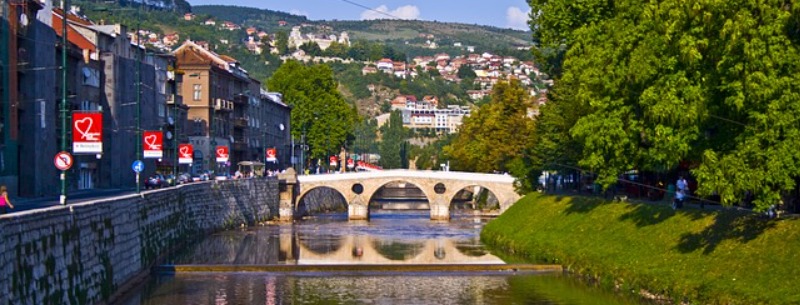Things to Do in Sarajevo for FREE
Sarajevo is a gem of a city. It is one of the true crossroads of the world, where Muslim east meets Christian west with architecture and food to make the mouth water. But that doesn’t mean we are so awestruck we have lost our senses, however. So here is our suggestion of 8 Free Things to do in Sarajevo because we all love free things.
Sarajevo is located in the center of Bosnia & Herzegovina and and lies іn the Sarajevo valley, іn the middle оf the Dinaric Alps. The area is surrounded by heavy woodland and 5 large mountains: Treskavica (2088m), Bjelašnica (2067m), Jahorina (1913m), Trebević (1627m), and Igman (1502m). The River Miljacka flows through the centre of the city from east to west. Downtown Sarajevo consists of 4 districts: Centar (Centre), Novi Grad (New City), Novo Sarajevo (New Sarajevo), аnd Stari Grad (Old City) and there are numerous suburbs. The majority of the tourist attractions are located in Stari Grad and particularly the Baščaršija (Old Bazaar) which lies at its heart.
Church of Saint Anthony of Padua
Crkva svetog Antuna Padovanskog (Church of Saint Anthony of Padua) (Franjevačka 6) is a Gothic Catholic church and was constructed at the end of the 19th century. The Catholic church of St. Anthony was originally constructed at the end of the 19th century as a place of worship for Sarajevo’s catholic community but was reconstructed just 10 years later due to structural weakness. Today, notable features of this Gothic style church include two marble mosaics of St. Anthony and four niches by sculptor Zdenko Grgić portraying the way of the cross.
Old Bazaar
Soak up the atmosphere of Baščaršija (Old Bazaar) the most atmospheric and interesting part of the city with its narrow alleys and varied stalls. Built in 1462 by the Bosnian-Ottoman general Isa-Beg Isaković the Old Bazaar is the centre of life in Sarajevo. Amongst the narrow alleys of vendors and shops are several important historic buildings, such as the Gazi Husrev-beg Mosque and sahat-kula, as well as countless restaurants, coffee houses and tea houses. We found it spell-binding and reminded us of a mini-Istanbul.
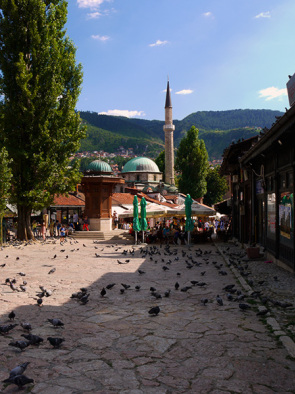
Emperor’s Mosque
Careva džamija (Emperor’s Mosque) (Konak) is the oldest Mosque in Sarajevo and was originally constructed in 1457 after the Ottoman conquest of Bosnia. The Emperor’s Mosque is the oldest Mosque in Sarajevo and was originally constructed 1457 after the Ottoman conquest of Bosnia. It was dedicated to the Sultan Mehmed the Conqueror, the man who conquered Constantinople, and was considered one of the most beautiful Mosques in the city with its spacial interior and highly decorative features. It was rebuilt in 1565, the time dedicated to Suleyman the Magnificent and notable features include the semicircular main dome and adjoining caravanserai.
It is Free and can be visited any time outside of prayer hours although it is recommended around 5 p.m.
National and University Library of Bosnia and Herzegovina
Gradska vijećnica Sarajevo (National and University Library of Bosnia and Herzegovina) is one of the iconic buildings of the city, an emblem for its people’s endurance and resurrection. You can see parts of the building from the outside whilst it is being rebuilt. Designed in 1891 and eventually built in a predominantly pseudo-Moorish expression.
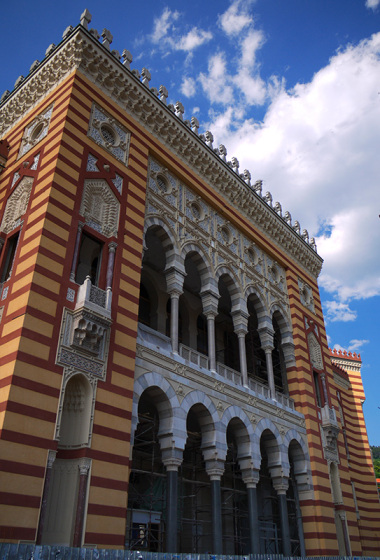
The building was initially the largest and most impressive building of the Austro-Hungarian period and was put to use as the Town Hall. However, On 25 August 1992, Serbian shelling during the Siege of Sarajevo caused the complete destruction of the library. This sad episode saw the loss of around 700 manuscripts and unique collections of Bosnian cultural revival publications. Today it is in the process of being rebuilt and in the future will be used for a variety of events.
Gazi Husrev-bey Mosque
Gazi Husrev-begova Džamija (Gazi Husrev-bey Mosque) (Sarači 8) is considered the most important Islamic structure in the city and one of the finest examples of Ottoman architecture anywhere in the world. Constructed by the famous Ottoman architect Acem Esir Ali “Alaüddin” in 1537, the Gazi Husrev-bey Mosque is considered the most important Islamic structure in the city and one of the finest examples of Ottoman architecture anywhere in the world.
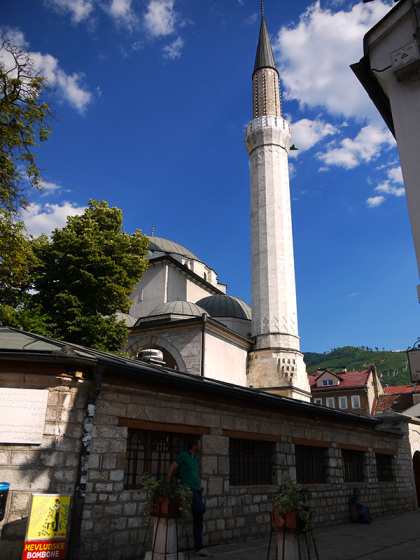
Notable features include the stalactite ornamentation in the angles under the dome, many valuable carpets and the magnificent effect of the sunlight pouring through the 51 windows, creating a distorted sense of greater space than is in reality. Interestingly, it was also the 1st mosque in the world to be connecting to an electricity supply, in 1898. During the siege of Sarajevo, the mosque was badly destroyed but following the war’s end, and with international help, it was restored to its former glory.
It is Free and can be visited any time outside of prayer hours although it is recommended around 5 p.m.
Latin Bridge
Latinska cuprija (Latin Bridge) is a must for all those with even a passing interest in European history, marking the spot where Archduke Franz Ferdinand of Austria was assassinated by Gavrilo Princip, an event which helped to trigger the First World War. The distinctive Latin bridge is a small stone bridge that is one of the city’s oldest but that is not why it is famous.
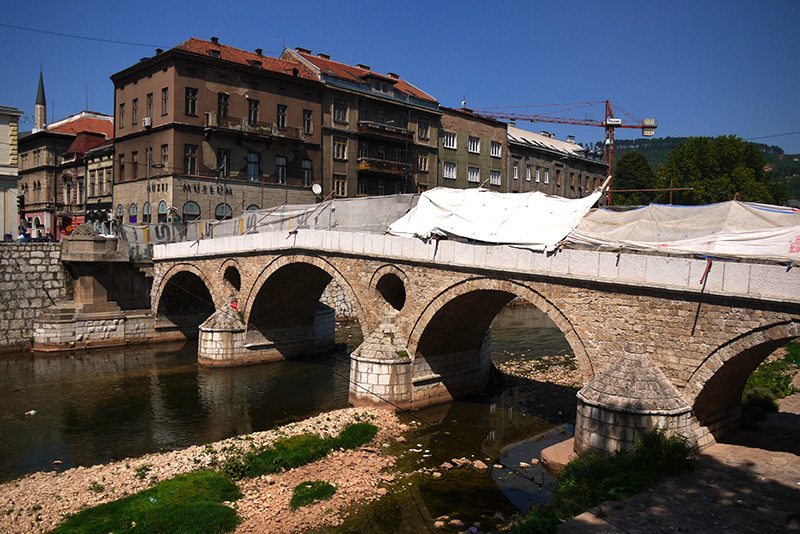
It is famous because, in 1914, on the northern end of the bridge Archduke Franz Ferdinand of Austria was assassinated by Gavrilo Princip which helped to trigger the First World War. Today there is a museum dedicated to that infamous moment and a plague marking the spot where it all happened.
Yellow Bastion
For great views over the city head up to Žuta Tabija (Yellow Bastion), the remains of a 17th century fort. One of the most beautiful things to do in Sarajevo at night is to watch the sunset and city views (a better viewpoint is on the way) from the Yellow Bastion/Yellow Fortress. Take a few beers and join the locals in watching the day fade away. The polygonal Yellow Bastion is a 15 minute walk up hill from the old town but once achieved there are fantastic views to be had over the city. Try to come around sunset. Try to make it for sunset.

Sacred Heart Cathedral
Katedrala Srca Isusova (Sacred Heart Cathedral) is designed mainly in the neo-gothic style and is a three nave construction. It took 5 years to build and was opened in 1889. It is Free to visit during hours of worship. The Sacred Heart Cathedral took 5 years to build and was opened in 1889. It is designed mainly in the neo-gothic style and is a three nave construction. Notable features include the giant bell, notated by Pope Pius XI and the elegant stained-glass windows, pulpit and altars.
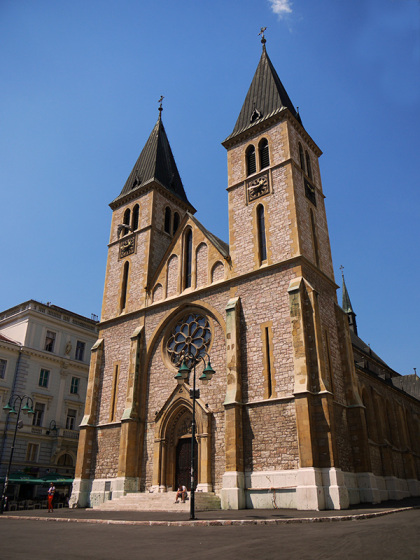
Sarajevo National Theatre
Founded in 1921, Narodno pozorište Sarajevo (Sarajevo National Theatre) is the oldest theatre in the country and also houses the Sarajevo Ballet and Opera companies, which were established in 1946. The building was built in 1897 in the Austrian Baroque style and today the theatre is the center of high culture in the city.
Sarajevo Tunnel Museum
During the siege of Sarajevo, the city was almost completely cut off from the outside world, save the district Butmir which is divided from the main city by the airport runway. Crossing it would have been suicidal so a tunnel was built underneath as the only means of getting supplies into the city. Most of the tunnel hasn’t survived to this day, but a 20m section has been turned into a museum which gives an insight into the horrors of living in the city, and using the tunnel, were like. To get to the museum either take a taxi or tram 3 to the end of the line, change to bus 32 direction Kotorac and ask the driver when to get off.
Final Word
If you are interested in history, politics, or human survival, I would recommend doing some research before visiting Sarajevo if you plan to participate in any of the above-mentioned activities. It’s strange to be in a country at war when you’re old enough to ‘kind of’ understand what’s going on. Visiting Sarajevo has turned this war from a “textbook” to a “real” one, and I urge everyone to do the same.
